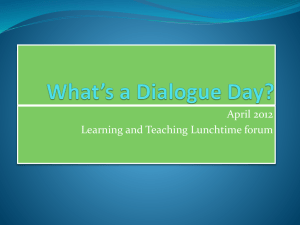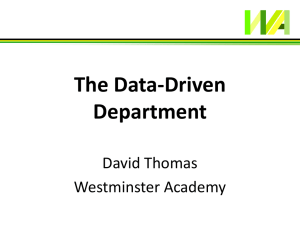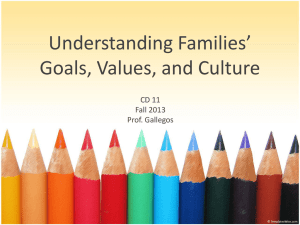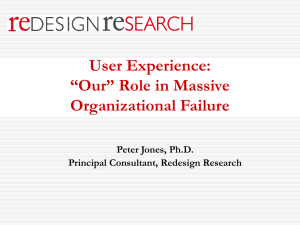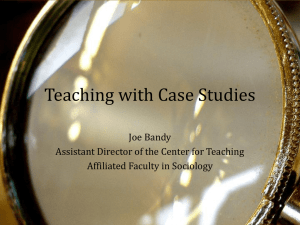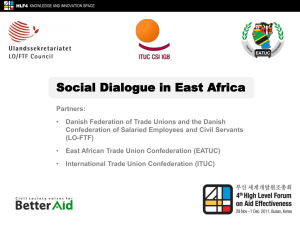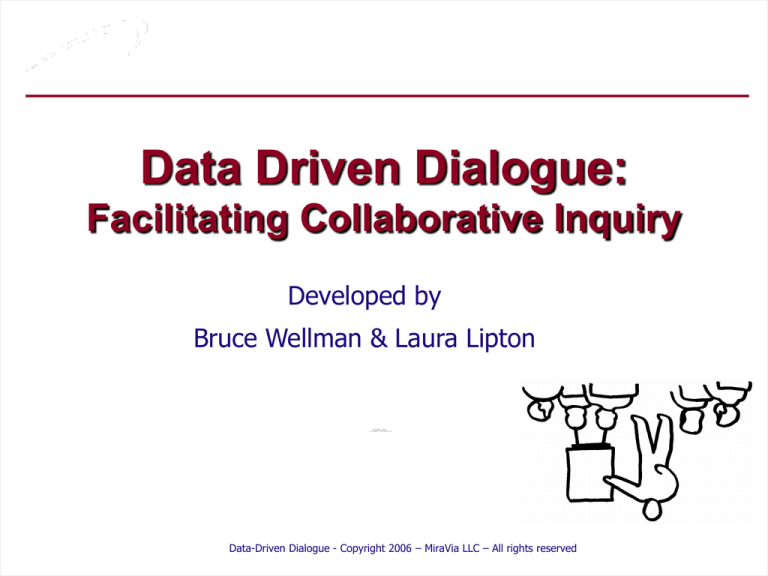
Data Driven Dialogue:
Facilitating Collaborative Inquiry
Developed by
Bruce Wellman & Laura Lipton
ar e
Q u ic k T im e ™ a n d a
No n e d e c o m p r e s s o r
n e e d e d t o s e e t h is p ic t u r e .
Data-Driven Dialogue - Copyright 2006 – MiraVia LLC – All rights reserved
Focusing Questions for School Improvement
H/O p. 4
1. What do we talk about around here?
2. How do we talk?
•structures •protocols •norms •consciousness
3. What don’t we talk about around here?
4. Why don’t we talk about what we don’t talk about….?
Data-Driven Dialogue - Copyright 2006 – MiraVia LLC – All rights reserved
Four Tensions
H/O p. 4
Task
Process
Comfort
Discomfort
Autonomy
Collaboration
Decision
Dialogue
Data-Driven Dialogue - Copyright 2006 – MiraVia LLC – All rights reserved
Outcomes
To develop practical structures for using data to
focus a group’s attention and energy.
To understand and apply a three-phase model
for guiding data-driven dialogue.
To extend a repertoire of tools for mediating
productive group learning, planning and problem
solving.
Data-Driven Dialogue - Copyright 2006 – MiraVia LLC – All rights reserved
Visual Synectics
School Improvement is like…..
Because…….
Data-Driven Dialogue - Copyright 2006 – MiraVia LLC – All rights reserved
Page 113
Crafting the Container - Pg. 12
Starting the Conversation
Structuring the Conversation
Sustaining Thinking in the Conversation
Data-Driven Dialogue - Copyright 2006 – MiraVia LLC – All rights reserved
Driving Forces - Pg. 2
Shifting From
Shifting to
• A teaching focus
• A learning focus
• Teaching as private
practice
• Teaching as collaborative
practice
• School improvement as
an option
• School improvement as
a requirement
• Accountability
• Responsibility
Data-Driven Dialogue - Copyright 2006 – MiraVia LLC – All rights reserved
Driving Forces - Pg. 5
Accountability:
Answerable,
From the Latin, cunter, compter -- to compute
and
From Old French, acunter, accomputare - to
count up, to reckon.
Data-Driven Dialogue - Copyright 2006 – MiraVia LLC – All rights reserved
Driving Forces - Pg. 5
Responsibility:
A duty, an obligation, to promise in return,
capable of making moral or rational decisions on
one’s own and therefore answerable for one’s
behavior.
From Latin. Respondere, to respond, obligation.
Response - ability
Data-Driven Dialogue - Copyright 2006 – MiraVia LLC – All rights reserved
Driving Forces - Pg. 2
Shifting From
Shifting to
• A teaching focus
• A learning focus
• Teaching as private
practice
• Teaching as collaborative
practice
• School improvement as
an option
• School improvement as
a requirement
• Accountability
• Responsibility
Data-Driven Dialogue - Copyright 2006 – MiraVia LLC – All rights reserved
TODAY
Welcome
Guiding Assumptions
Developing Dialogue
Sources of Data
Organizing and Integrating
Data-Driven Dialogue - Copyright 2006 – MiraVia LLC – All rights reserved
Meeting Partners - Handout Pg. 21
DATA
Your Partner’s Name
GROUP
MEDIA
CHART PERSON
Data-Driven Dialogue - Copyright 2006 – MiraVia LLC – All rights reserved
Facilitation Tip Page 13
Skilled facilitators offer the
• ‘What’
• ‘Why’
• ‘How’
of strategies and protocols
Data-Driven Dialogue - Copyright 2006 – MiraVia LLC – All rights reserved
Think, WRITE, Pair Share
One assumption I
have about
helping groups
work with data…
Join your
Partner
and share
Data-Driven Dialogue - Copyright 2006 – MiraVia LLC – All rights reserved
BREAK
Please return at 10:50
Data-Driven Dialogue - Copyright 2006 – MiraVia LLC – All rights reserved
Say Something
1. Choose a partner
2. Read silently to the designated stopping point.
3. When each partner is ready, stop and “say something”.
*the ‘something’ might be a question, a brief summary,
a key point, an interesting idea or personal connection.
4. Continue the process until you have completed the
selection.
Data-Driven Dialogue - Copyright 2006 – MiraVia LLC – All rights reserved
Guiding Assumptions pg. xi
Data have no meaning
Knowledge is both a personal and social construction
There is a reciprocal influence between the culture of the
workplace and the thinking and behavior of its members
Understanding should precede planning
Cycles of inquiry, experimentation and reflection
accelerate continuous growth and learning
Norms of data-driven collaborative inquiry generate
continuous improvements in student learning
Data-Driven Dialogue - Copyright 2006 – MiraVia LLC – All rights reserved
Processing the Strategy
• What are some of the ways that the structure of
the strategy influenced you?
• What are some ways that paired interaction
influenced you?
Data-Driven Dialogue - Copyright 2006 – MiraVia LLC – All rights reserved
Guiding Assumptions
Data have no meaning
Knowledge is both a personal and social construction
There is a reciprocal influence between the culture of the
workplace and the thinking and behavior of its members
Understanding should precede planning
Cycles of inquiry, experimentation and reflection
accelerate continuous growth and learning
Norms of data-driven collaborative inquiry generate
continuous improvements in student learning
Data-Driven Dialogue - Copyright 2006 – MiraVia LLC – All rights reserved
Guiding Assumptions
With your partner, choose one guiding
assumption that caught your attention and be
prepared to share some of your connections.
Data-Driven Dialogue - Copyright 2006 – MiraVia LLC – All rights reserved
Guiding Assumptions
Data have no meaning
Knowledge is both a personal and social construction
There is a reciprocal influence between the culture of the
workplace and the thinking and behavior of its members
Understanding should precede planning
Cycles of inquiry, experimentation and reflection
accelerate continuous growth and learning
Norms of data-driven collaborative inquiry generate
continuous improvements in student learning
Data-Driven Dialogue - Copyright 2006 – MiraVia LLC – All rights reserved
First Turn/ Last Turn
• Read 38-40 individually. Highlight 2-3 items.
• In turn – share one of your items – but do not
comment on it. -- The First Turn
• Group members comment in round-robin order about the item
(with no cross-talk).
• The initial person who names the item then shares his or her
thinking about the item and gets – The Last Turn.
---------------------------------------------------------------------• Repeat the pattern around the table.
Data-Driven Dialogue - Copyright 2006 – MiraVia LLC – All rights reserved
First Turn/ Last Turn
1. How is this strategy a scaffold for dialogue?
2. How might this strategy contribute to group development?
Data-Driven Dialogue - Copyright 2006 – MiraVia LLC – All rights reserved
Matchbook Definitions - Pg. 106
Craft a “Matchbook Definition” of Dialogue
Approximately 8-12 words in length.
Quic kTime™ and a
TIFF ( Unc ompres s ed) decompr es s or
are needed to s ee this picture.
Data-Driven Dialogue - Copyright 2006 – MiraVia LLC – All rights reserved
LUNCH
Please return at 1:00
Data-Driven Dialogue - Copyright 2006 – MiraVia LLC – All rights reserved
Managing Decisions - Pg. 67
Group
size
Length of
time
Degree of
structure
Data-Driven Dialogue - Copyright 2006 – MiraVia LLC – All rights reserved
Processing the Morning
Reflect on the morning
select a
“Most Important Point”
Listen carefully to each other
and be prepared to share
your partner’s “MIP”.
Join your
Partner
and share
Data-Driven Dialogue - Copyright 2006 – MiraVia LLC – All rights reserved
Pg. 41
DIALOGUE
-----
DISCUSSION
thinking holistically
thinking analytically
making connections
making distinctions
surfacing and inquiring
into assumptions
surfacing and inquiring
into assumptions
developing shared
meaning
developing agreement
on action
seeking understanding
seeking decisions
Data-Driven Dialogue - Copyright 2006 – MiraVia LLC – All rights reserved
Related Words
• Incision
• Precision
• Recision
• Decision
Data-Driven Dialogue - Copyright 2006 – MiraVia LLC – All rights reserved
Decide -- Related Words
With your partner, generate other
words that end in the suffix cide.
Data-Driven Dialogue - Copyright 2006 – MiraVia LLC – All rights reserved
Application
With a neighbor, generate some
examples from your work in which
engaging a group in purposeful
dialogue would be the most effective
choice.
Data-Driven Dialogue - Copyright 2006 – MiraVia LLC – All rights reserved
Round the Room & Back Again
• List one source of data that you use to improve
student learning
• Without taking notes, move round the room and
share your data source and mentally catalogue the
sources of others.
• Return to home-base and write down the ideas you
can remember.
• Pool your lists and make the longest discrete list that
is possible
Data-Driven Dialogue - Copyright 2006 – MiraVia LLC – All rights reserved
Sources of Data - H/O Pg. 5
DATA
QUANTITATIVE
QUALITATIVE
Student
Performance Data
Program
Data
Community
Data
Data-Driven Dialogue - Copyright 2006 – MiraVia LLC – All rights reserved
Process
What are some patterns you are
noticing?
What might you add/ refine?
What data “speaks” to which
audiences?
Data-Driven Dialogue - Copyright 2006 – MiraVia LLC – All rights reserved
“Not everything that counts can be
counted. And not everything that can
be counted, counts.”
- Albert Einstein
Data-Driven Dialogue - Copyright 2006 – MiraVia LLC – All rights reserved
Informational Altitudes
International
National
State/Province
District
School/C.R.
TIMMS, I.B., I.A.E.P., PISA
Terra Nova, CTBS, ITBS, Stanford 9, SAT, ACT
Standards-Driven Assessments, End of Course Exams
Rubrics, Scales and Checklists
District-wide Assessments
Publishers’ Tests
IRI/Running Records
Reading Conferences
Think Alouds
Portfolios
Teacher-made tests
Data-Driven Dialogue - Copyright 2006 – MiraVia LLC – All rights reserved
BREAK
Please return at 2:45
Data-Driven Dialogue - Copyright 2006 – MiraVia LLC – All rights reserved
For Tomorrow
Read pages 9-17
Identify 5 significant ideas
Use Page 7 of the handout to record your ideas
Be ready to share your thinking
Data-Driven Dialogue - Copyright 2006 – MiraVia LLC – All rights reserved
Choosing Which Data to Collect
Three Ways to Frame a Problem
Observation:
Many of our students do not turn in their
math homework.
Question:
What is the relationship between our
current math homework assignments and
our students’ performance?
HYPOTHESIS:
Student math performance would improve
if homework assignments offered more
authentic tasks and real-world applications.
Data-Driven Dialogue - Copyright 2006 – MiraVia LLC – All rights reserved
CHOOSING WHICH DATA
TO COLLECT
Identify something in your own work setting that you
are interested in knowing more about.
1. Develop an observation, a question, and an
hypothesis.
2. Decide which of the three potential ways of framing
the issue might be the most productive way to engage
some group that you have in mind.
3. Determine at least three data sources you might
“tap” to explore your issue.
Data-Driven Dialogue - Copyright 2006 – MiraVia LLC – All rights reserved
Organizing and Integrating
Table Groups:
Craft a “One-Word Summary” of this day.
Be prepared to share:
• your word, the ‘what’
• your reasons for choosing, the ‘why’
• your spokesperson, the ‘who’
Data-Driven Dialogue - Copyright 2006 – MiraVia LLC – All rights reserved




